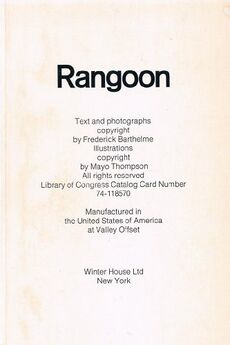Rangoon: Difference between revisions
Appearance
imported>Dotclub No edit summary |
imported>Dotclub No edit summary |
||
| Line 2: | Line 2: | ||
A novel by [[Frederick Barthelme]], illustrated by [[Mayo Thompson]]. Published in 1971 by Winter House Ltd. | A novel by [[Frederick Barthelme]], illustrated by [[Mayo Thompson]]. Published in 1971 by Winter House Ltd. | ||
== Contents == | |||
* North American homes | |||
* OPO: more girl | |||
* Regular everything | |||
* Mr. and Mrs. Frank Future | |||
* But.. | |||
* Metasensorialism and extralogic | |||
* A short decade of emotions | |||
* The Richard Widmark nets | |||
* Dear Blue Alert Captain | |||
* The chair | |||
* On the availability of proof, circa 1967 | |||
* The patrolman's signature | |||
* Bark, arf | |||
* Gregory Park | |||
* Theories of universe | |||
* Monitor Rotinom | |||
* Some plumbing | |||
* 90° | |||
* Peru | |||
* Babs | |||
* Great ideas in modern geography .. | |||
* Sport-mated | |||
== Reviews == | == Reviews == | ||
Revision as of 14:33, 6 November 2022

A novel by Frederick Barthelme, illustrated by Mayo Thompson. Published in 1971 by Winter House Ltd.
Contents
- North American homes
- OPO: more girl
- Regular everything
- Mr. and Mrs. Frank Future
- But..
- Metasensorialism and extralogic
- A short decade of emotions
- The Richard Widmark nets
- Dear Blue Alert Captain
- The chair
- On the availability of proof, circa 1967
- The patrolman's signature
- Bark, arf
- Gregory Park
- Theories of universe
- Monitor Rotinom
- Some plumbing
- 90°
- Peru
- Babs
- Great ideas in modern geography ..
- Sport-mated
Reviews
| Date | Publication | Author | Link | |
|---|---|---|---|---|
| Spring 1972 | Prairie Schooner: Vol. 46, No. 1 | JSTOR (requires login) | ||
| Library Journal | ||||
| 2003 | pg.5-7 | John Calvin Hughes | ProQuest |
Interpretations
- Barthelme: My first two books, Rangoon and War & War, came out of the world of visual art. I liked the "book" as a container. I was interested in Daniel Spoerri's Anecdoted Topography of Chance (since renamed, I believe). My first two are hard to read now, in part because my literary interests were minimal, in part because they're often clumsily written and adolescent and in part because plastic art ideas didn't translate very comfortably to the literary form. In defense of these books, I can say that a lot of people have done the same things a lot better since.[1]
- ↑ Barthelme, F., Oates, N., & Wilkinson, A. D. (2004). An Interview with Frederick Barthelme. The Missouri Review, 27(2), 39–53.